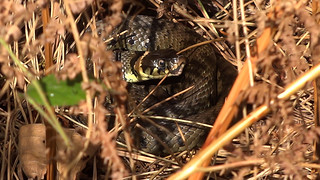I'm not sure if this is practical if you have a large area - this is from a pond maint' prospective.
Quote; Pruning
Remove dead, faded, or damaged leaves, stems, and flowers as needed
Cut dormant plants back to prevent dead parts from settling into the water and creating a nasty mess later
http://www.learn2grow.com/plants/typha- ... intenance/
Whoa! Found it....
Maintenance and Replacement of the system
Reed bed systems are not low maintenance and a regular maintenance programme is required to keep them working properly. The reed beds that work are usually those whose owners love gardening, do not have a big enough garden to keep themselves occupied and are not worried by coming into contact with faecal bacteria, spiders, Grass Snakes (they love reedbeds), mice, rats and their associated diseases. The 'gardeners' will also require several injections every year against leptospirosis, Hepatitis, etc. so fear of needles is also a nuisance.
Points to consider:
The flow through the bed is even and regulated using balancing tanks and pumps if necessary.
Reed growth is always vigorous, even, and that any gaps are quickly re-planted.
Weeds are removed as quickly as possible and the bare patch re-planted with reeds
Dead reeds should be harvested and composted every October to prevent them from rotting onto the surface of the bed and clogging it. It also promotes healthy new reed growth in the Spring.
Any preferential pathways created by the flow of effluent are disrupted by digging up the bed and an even flow is re-established over the entire area.
During very cold weather, such as that experienced in the winters of 2010/2011, reed beds can freeze solid and alternative arrangements must be made for foul drainage and sanitation. This is a new situation in the UK as we have not experienced this type of arctic weather since reed beds were invented.
The 'Gardener' of the bed invariably comes into contact with some very nasty bacteria and viruses, so it is vital that vaccinations against Diphtheria, Typhoid, Tetanus, Polio, Leptospirosis and Hepatitis are kept rigorously up to date.
The reed bed area is fenced to prevent children and animals coming into contact with the sewage water. Any fencing issues must be rectified as soon as possible.
Weedkiller spray must never be allowed to drift onto the bed.
Any clogged areas of gravel must be removed, new gravel installed and the section re-planted.
Reed beds tend to attract rodents, particularly in the winter, so unless you like rats and mice, you may want to consider some kind of pest control system.
Grass Snakes tend to be abundant in reedbeds, making their nests, laying their eggs and hibernating in the dense bottom vegetation. They are completely harmless however.
The septic tank must be emptied on a regular basis - at least annually.
Most of the clogging problems occur at the inlet and outlet end of the bed. If the blockage is at the inlet end, then the septic tank or sewage plant can 'back-up' and prevent use of the foul drainage system. If it is at the outlet end, then the reed-bed will flood and can overflow.
http://www.wte-ltd.co.uk/reed_bed_sewage_treatment.html


